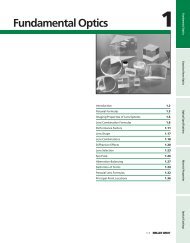Intel PXA250 and PXA210 Applications Processors
Intel PXA250 and PXA210 Applications Processors
Intel PXA250 and PXA210 Applications Processors
Create successful ePaper yourself
Turn your PDF publications into a flip-book with our unique Google optimized e-Paper software.
.<br />
I2C<br />
Figure 7-2. Using an Analog Switch to Allow a Second CF Card<br />
DC3P3V<br />
U26<br />
MAX4547<br />
V*<br />
2<br />
SA_I2C_SCL<br />
8<br />
COM_1<br />
7<br />
IN_7<br />
NC_1<br />
1<br />
CF_I2C_SCL<br />
SA_I2C_SDA<br />
SA_I2C_ENAB<br />
4<br />
3<br />
COM_7<br />
IN_2<br />
NC_2<br />
GND<br />
5<br />
6<br />
CI_I2C_SDA<br />
AAAF<br />
A8750-01<br />
7.1.4 Pull-Ups <strong>and</strong> Pull-Downs<br />
The I 2 C Bus Specification, available from Philips Corporation, states:<br />
The external pull-up devices connected to the bus lines must be adapted to accommodate the shorter<br />
maximum permissible rise time for the Fast-mode I 2 C-bus. For bus loads up to 200 pF, the pull-up<br />
device for each bus line can be a resistor; for bus loads between 200 pF <strong>and</strong> 400 pF, the pull-up device<br />
can be a current source (3 mA max.) or a switched resistor circuit.<br />
The design presented in this guide is not intended for loads larger than 200pF, so the pull-up device is a<br />
resistor as shown in Figure 7-3.<br />
Figure 7-3. I 2 C Pull-Ups <strong>and</strong> Pull-Downs<br />
DC3P3V<br />
SA_I2C_SCL<br />
SA_I2C_SDA<br />
R4<br />
4.99K<br />
R5<br />
4.99K<br />
A8751-01<br />
<strong>PXA250</strong> <strong>and</strong> <strong>PXA210</strong> <strong>Applications</strong> <strong>Processors</strong> Design Guide 7-3
















